
Concept explainers
(a)
Interpretation:
The IUPAC name of given compound is to be stated.
Concept introduction:
Carboxylic acids are the carbon compounds that contain carboxyl group as a major
The chemical structures are described by IUPAC name or common names. IUPAC names are totally different from common names because IUPAC names are applied at international level and it comprises suffix, prefix, numbers and other priority rules.
(a)
Answer to Problem 20.25SP
The
Explanation of Solution
The chemical structure of the given compound is shown in figure 1.

Figure 1
The structure comprises chain of five carbon atoms along with
Therefore, the
(b)
Interpretation:
The IUPAC name of given compound is to be stated.
Concept introduction:
Carboxylic acids are the carbon compounds that contain carboxyl group as a major functional group. These are polar compounds due to difference in an electronegativity of the atoms in a compound.
The chemical structures are described by IUPAC name or common names. IUPAC names are totally different from common names because IUPAC names are applied at international level and it comprises suffix, prefix, numbers and other priority rules.
(b)
Answer to Problem 20.25SP
The
Explanation of Solution
The chemical structure of the given compound is shown in figure 2.
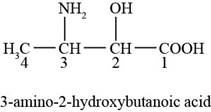
Figure 2
The structure comprises chain of four carbon atoms along with carboxylic acid group, hydroxyl group and amino group at first, second, and third carbon atoms respectively. Carboxylic acid group gets higher priority during the naming of structure because it is present at first carbon atom. According to
Therefore, the
(c)
Interpretation:
The IUPAC name of given compound is to be stated.
Concept introduction:
Carboxylic acids are the carbon compounds that contain carboxyl group as a major functional group. These are polar compounds due to difference in an electronegativity of the atoms in a compound.
The chemical structures are described by IUPAC name or common names. IUPAC names are totally different from common names because IUPAC names are applied at international level and it comprises suffix, prefix, numbers and other priority rules.
(c)
Answer to Problem 20.25SP
The
Explanation of Solution
The chemical structure of the given compound is shown in figure 3.
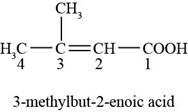
Figure 3
The structure comprises chain of four carbon atoms along with carboxylic acid group and methyl group at first and third carbon atoms respectively. The double bond is present in between the second and third carbon atoms. Carboxylic acid group gets higher priority during the naming of structure because it is present at first carbon atom. According to
Therefore, the
(d)
Interpretation:
The IUPAC name of given compound is to be stated.
Concept introduction:
Carboxylic acids are the carbon compounds that contain carboxyl group as a major functional group. These are polar compounds due to difference in an electronegativity of the atoms in a compound.
The chemical structures are described by IUPAC name or common names. IUPAC names are totally different from common names because IUPAC names are applied at international level and it comprises suffix, prefix, numbers and other priority rules.
(d)
Answer to Problem 20.25SP
The
Explanation of Solution
The chemical structure of the given compound is shown in figure 4.
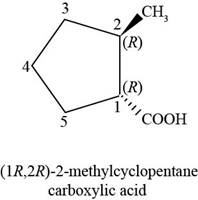
Figure 4
The structure comprises cyclic ring of five carbon atoms along with one group of carboxylic acids at first carbon atom and one methyl group at second carbon atom. The carboxylic acid group is present below the plane, whereas methyl group is present at above the plane. According to
Therefore, the
(e)
Interpretation:
The IUPAC name of given compound is to be stated.
Concept introduction:
Carboxylic acids are the carbon compounds that contain carboxyl group as a major functional group. These are polar compounds due to difference in electronegativity of the atoms in a compound.
The chemical structures are described by IUPAC name or common names. IUPAC names are totally different from common names because IUPAC names are applied at international level and it comprises suffix, prefix, numbers and other priority rules.
(e)
Answer to Problem 20.25SP
The
Explanation of Solution
The chemical structure of the given compound is shown in figure 5.
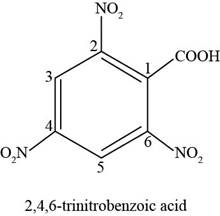
Figure 5
The structure comprises cyclic ring of six carbon atoms along with one carboxylic acid group at first position and three nitro groups at second, fourth and sixth carbon atoms. According to
Therefore, the
(f)
Interpretation:
The IUPAC name of given compound is to be stated.
Concept introduction:
Carboxylic acids are the carbon compounds that contain carboxyl group as a major functional group. These are polar compounds due to difference in electronegativity of the atoms in a compound.
The chemical structures are described by IUPAC name or common names. IUPAC names are totally different from common names because IUPAC names are applied at international level and it comprises suffix, prefix, numbers and other priority rules.
(f)
Answer to Problem 20.25SP
The
Explanation of Solution
The chemical structure of the given compound is shown in figure 6.
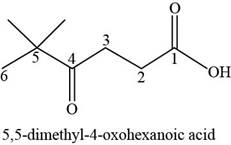
Figure 6
The structure comprises parent chain of six carbon atoms along with carboxylic acid group, carbonyl group, and two methyl groups at first, fourth and fifth carbon atoms respectively. According to
Therefore, the
Want to see more full solutions like this?
Chapter 20 Solutions
EP ORGANIC CHEMISTRY -MOD.MASTERING 18W
- 6. For each of the following, fill in the synthesis arrows with reagents and show the intermediates. You DO NOT need to use the same number of arrows that are shown (you may use more or less), but the product must be formed from the reactant. Then write the mechanism of one step in the synthesis (you can choose which step to write the mechanism for), including all reagents required, clearly labeling the nucleophile and electrophile for each step, and using curved arrows to show the steps in the mechanism. a. b. OHarrow_forwardDraw the productsarrow_forwardDraw the correct productsarrow_forward
- E Organic Chemistry Maxwell Draw the correct products, in either order, for the ozonolysis reaction: 1) O3, CH2Cl2, -78 °C Product 1 + Product 2 2) Zn, HOAc Draw product 1. Select Draw Templates More C H O presented by M Draw product 2. Erase Select Draw Templates M / # # carrow_forward✓ edict the products of this organic reaction: ---- ။ A CH3–C−NH–CH2–C−CH3 + KOH ? Specifically, in the drawing area below draw the condensed structure of the product, or products, of this reaction. If there's more than one product, draw them in any arrangement you like, so long as they aren't touching. If there aren't any products because this reaction won't happen, check the No reaction box under the drawing area. Explanation Check Click anywhere to draw the first atom of your structure. C 2025 McGraw Hill LLC. All Rights Reserved. Terms of Use | Privacy Center | Accessibiliarrow_forwardPredict the product of this organic reaction: A HO-C-CH3 + CH3NH2 P+ H2O Specifically, in the drawing area below draw the condensed structure of P. If there is no reasonable possibility for P, check the No answer box under the drawing area. Explanation Check Click anywhere to draw the first atom of your structure. marrow_forward
- H 1) OsO4, pyridine 2) Na2SO3 or NaHSO3 in H₂O 2 productsarrow_forward● Biological Macromolecules Naming and drawing cyclic monosaccharides Your answer is incorrect. • Row 1: Your answer is incorrect. Row 3: Your answer is incorrect. • Row 4: Your answer is incorrect. Try again... 0/5 Give the complete common name, including anomer and stereochemistry labels, of the following molecules. You will find helpful information in the ALEKS resource. CH2OH OH OH H H I H OH OH H] H CH2OH H OH ẞ-L-sorbose HOCH2 OH OH H HOCH2 H OH OH H OH H H CH2OH OH H H OH H I- H OH H OH Explanation Recheck W E R % 25 α B Y X & 5 D F G H McGraw Hill LLC. All Rights Reserved. Terms of Use | Pr Parrow_forwardWhat is the missing reactant in this organic reaction? + R -A HO IN + H₂O Specifically, in the drawing area below draw the skeletal ("line") structure of R. If there is more than one reasonable answer, you can draw any one of them. If there is no reasonable answer, check the No answer box under the drawing area. Note for advanced students: you may assume no products other than those shown above are formed. Explanation Check Click and drag to start drawing a structure. © 2025 McGraw Hill LLC. All Rights Reserved. Terms of Use | Privacy Centerarrow_forward
- Stuc X ctclix ALE X A ALE אן A ALEX Lab (195 X Nut x M Inb x NU X NUT X Unt x + → C www-awu.aleks.com/alekscgi/x/Isl.exe/10_u-lgNslkr7j8P3jH-IQ1g8NUi-mObKa_ZLx2twjEhK7mVG6PulJI006NcKTV37JxMpZuyrVCdQolLAKqp_7U3r1GUD3... New Chrome available: Naomi Question 26 of 39 (4 points) | Question Attempt: 1 of Unlimited Give the IUPAC name. 2,3-dimethylhexane Part: 1/2 Part 2 of 2 Draw the skeletal structure of a constitutional isomer of the alkane above that contains a different number of carbons in its longest chain. Skip Part Check Click and drag to start drawing a structure. 3 Finance headline Q Search mwa Harvard Intensifi... X Save For Later 00 dlo HB Submit Assignment 2025 McGraw Hill LLC. All Rights Reserved. Terms of Use | Privacy Center | Accessibility a 9:11 PM 4/22/2025arrow_forwardPredict the product of this organic reaction: + NH2 HO A P+ H2O Specifically, in the drawing area below draw the skeletal ("line") structure of P. If there is no reasonable possibility for P, check the No answer box under the drawing area. Click and drag to start drawing a structure. ✓arrow_forward个 Stuc X ctclix ALE X A ALE × A ALE X Lab x (195 × Nut x M Inbx EF 目 → C www-awu.aleks.com/alekscgi/x/Isl.exe/10_u-IgNslkr7j8P3jH-IQ1g8NUi-mObKa_ZLx2twjEhK7mVG6PulJI006NcKTV37JxMpz Chapter 12 HW = Question 27 of 39 (5 points) | Question Attempt: 1 of Unlimited Part: 1/2 Part 2 of 2 Give the IUPAC name. Check 3 50°F Clear ©2025 McGraw Hill L Q Search webp a عالياكarrow_forward
- Chemistry: Matter and ChangeChemistryISBN:9780078746376Author:Dinah Zike, Laurel Dingrando, Nicholas Hainen, Cheryl WistromPublisher:Glencoe/McGraw-Hill School Pub Co
